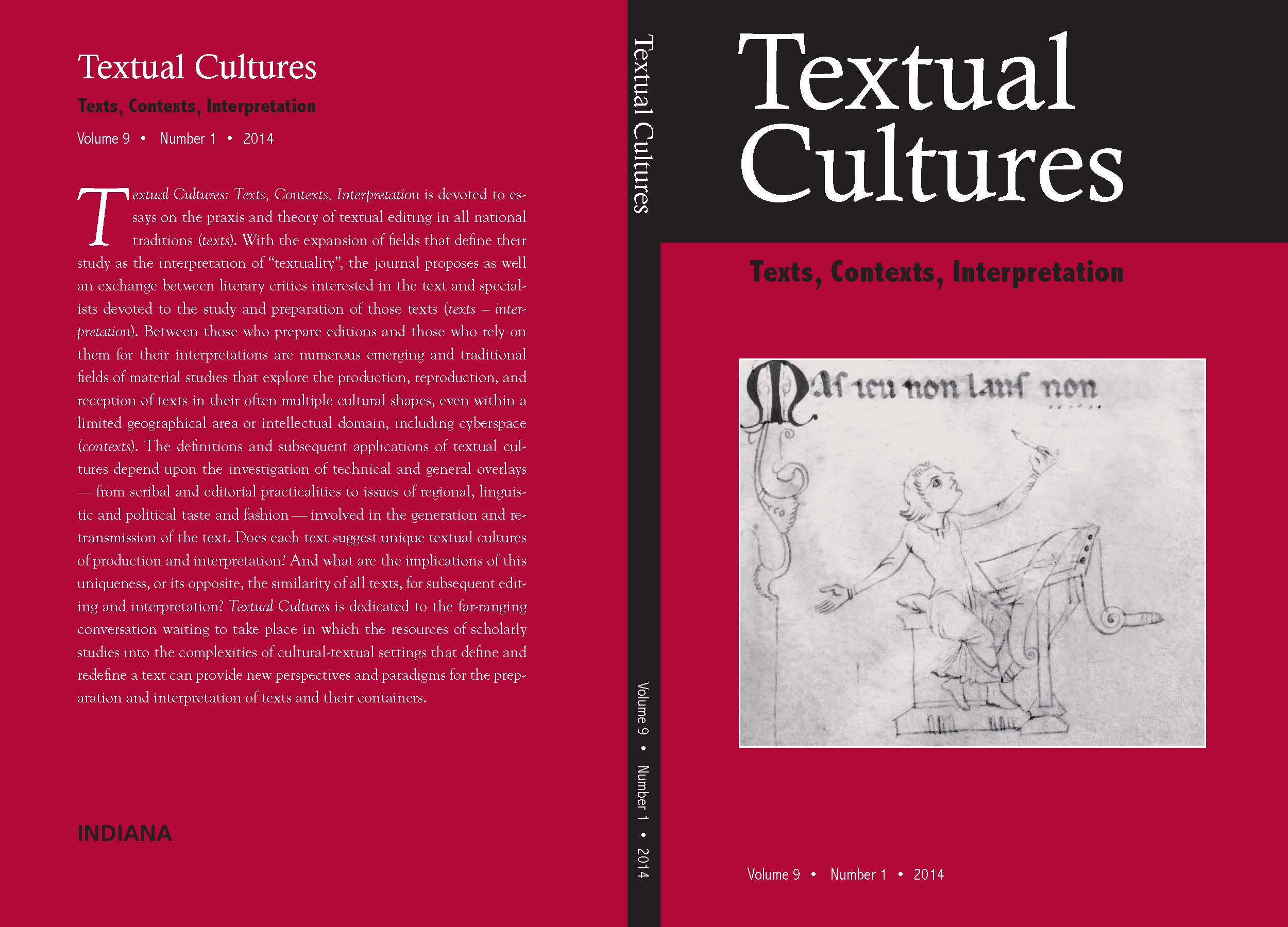“On the Early Letters of Ernest Hemingway: Teasing, Typing, Editing”
Main Article Content
Abstract
Ernest Hemingway has rarely seemed a reliable pen pal, not through any fault of his own, but because the evidence for determining any such identity has been hard to assemble. In 2011, Sandra Spanier and Robert W. Trogdon published the first volume of Hemingway’s collected letters, and in doing so, prompted a reevaluation of his epistolary habit; one that requires careful editing and close textual scrutiny. Taking the first volume of the new Letters as a case study, this essay offers an interpretative approach to matters of textuality, typographic expression, and mechanical accident that lie at the heart of Hemingway’s early life-writing.
Downloads
Article Details
Authors who publish with this journal agree to the following terms:
- Authors retain copyright and grant the journal right of first publication with the work simultaneously licensed under a Creative Commons Attribution License (see:http://creativecommons.org/licenses/by/3.0/us/) that allows others to share the work with an acknowledgment of the work's authorship and initial publication in this journal.
- Authors warrant that their submission is their own original work, and that they have the right to grant the rights contained in this license. Authors also warrant that their submission does not, to the best of your knowledge, infringe upon anyone's copyright. If the submission contains material for which an author does not hold the copyright, authors warrant that they have obtained the unrestricted permission of the copyright owner to grant Indiana University the rights required by this license, and that such third-party owned material is clearly identified and acknowledged within the text or content of their submission.
- Authors are able to enter into separate, additional contractual arrangements for the non-exclusive distribution of the journal's published version of the work (e.g., post it to an institutional repository or publish it in a book), with an acknowledgment of its initial publication in this journal.
References
Boddy, Kasia. 2008. Boxing: A Cultural History. London: Reaktion.
Burgess, Anthony. 1981. “Opening Hemingway’s Mail”. The Saturday Review 8.4: 64– 65.
Cirino, Mark. 2012. Ernest Hemingway: Thought in Action. Madison: University of Wisconsin Press.
Cohen, Milton A. 2005. Hemingway’s Laboratory: The Paris “in our time”. Tuscaloosa: University of Alabama Press.
After a couple of shaky mid-series games against the New York Giants, the White Sox clinched the World Championship on 15 October 1917, with a final series score of 6–4.
Diliberto, Gioia. 1992. Hadley: A Life of Hadley Richardson Hemingway. New York: Ticknor & Fields.
Ferguson, Andrew. 2013. “Mirror World, Minus World: Glitching Nabokov’s Pal e Fire”. Textual Cultures 8.1: 101–16.
Frost, Robert. 2014. The Letters of Robert Frost: 1886–1920, edited by Donald Sheehy, Mark Richardson, and Robert Faggen, vol. 1. Cambridge, MA: Belknap Press.
Goodale, Dora Read (with Elaine Goodale). 1878. Apple-Blossoms: Verses of Two Children. New York: G. P. Putnam’s Sons.
Griffin, Peter. 1985. Along with Youth: Hemingway, The Early Years. Oxford: Oxford University Press.
Heidegger, Martin. 1992. “Concealment and Forgetting”. In Parmenides, translated by André Schuwer and Richard Rojcewicz. Bloomington, Indiana University Press: 71–87.
Hemingway, Ernest. 1995. The Collected Stories, edited by James Fenton. London: D. Campbell.
——— . 1 9 7 9 . 88 Poems, edited by Nicholas Gerogiannis. New York: Harcourt Brace Jovanovich.
——— . 2 0 1 1 . The Letters of Ernest Hemingway, 1907–1922, edited by Sandra Spanierand Robert W. Tr o gd on, vol. 1. Cambridge: Cambridge University Press.
——— . 1 9 8 1 . Sel ect ed L et t e rs, 1917–1961, edited by Carlos Baker. London: Panther.
———. 1970. “Six Men Become Tankers”. Kansas City Star (17 April 1918). Reprinted in Ernest Hemingway, Cub Reporter:Kansas City Star Stories, edited by Matthew J. Bruccoli. Pittsburgh: University of Pittsburgh Press: 41–44.——— . 2 0 0 4 . The Sun Also Rises. London: Arrow Books.
Jarvis, Simon. 2011. “To the Letter”. Textual Practice 25: 233–43.
Kenner, Hugh. 1987. The Mechanic Muse. Oxford: Oxford University Press.
Kittler, Friedrich A. 1999. Gramophone, Film, Typewriter, translated by Geoffrey Winthrop-Young and Michael Wutz. Stanford: Stanford University Press.
Lamb, Robert Paul. 2010. Art Matters: Hemingway, Craft, and the Creation of the Mod-ern Short Story. Baton Rouge: Louisiana State University Press.
London, Jack. 2009. John Barleycorn, edited by John Sutherland. Oxford: Oxford University Press.
Madsen, Diane Gilbert. 2013. “‘To Pound a Vicious Typewriter’: Hemingway’s Corona # 3”. The Hemingway Review 32.2: 109–21.
Meyers, Jeffrey. 1986. Hemingway: A Biography. London: Macmillan.
O’Hagan, Andrew. 2012. “Issues for His Prose Style”. London Review of Books 34.11: 6–8.
Pound, Ezra. 1923. Indiscretions; or, Une Revue de Deux Mondes. Paris: Three Moun-tains Press.
———. 1918. “Moeurs Contemporaines”. The Little Review 6.1: 26 – 31.
Schulze, Robin G. 2007. “How Not to Edit: The Case of Marianne Moore”. Te x t u a l Cultures 2.1: 119–35.
Sitar, James. 2007. “Frost’s Great Misgiving”. Essays in Criticism 57.4: 36 4–72.
Stillman, Anne. 2010. “Discretion and Indiscretion in the Letters of T. S. Eliot”. The Cambridge Quarterly 39.4: 370–80.
Sullivan, Hannah. 2013. The Work of Revision. Cambridge, MA: Harvard University Press.
Sylvester, A. J. 1916. Underwood Typewriter Manual. London: Sir Isaac Pitman & Sons.
Villard, Henry Serano and James Nagel, eds. 1989. Hemingway in Love and War: The Lost Diary of Agnes von Kurowsky. Boston: Northeastern University Press.
Wagner-Martin, Linda. 2007. Ernest Hemingway: A Literary Life. Basingstoke: Pal-grave Macmillan.
Wershler-Henry, Darren. 2005. The Iron Whim: A Fragmented History of Typewrit-ing. Toronto: McClelland and Stewart.
Yalom, Irvin D. and Marilyn Yalom. 1971. “Ernest Hemingway — A Psychiatric View ”. Archives of General Psychiatry 24: 485–94.Sanford, Marcelline Hemingway. 1999. At the Hemingways: With Fifty Years of Cor-respondence Between Ernest and Marcelline Hemingway. Moscow, ID:University of Idaho Press.
